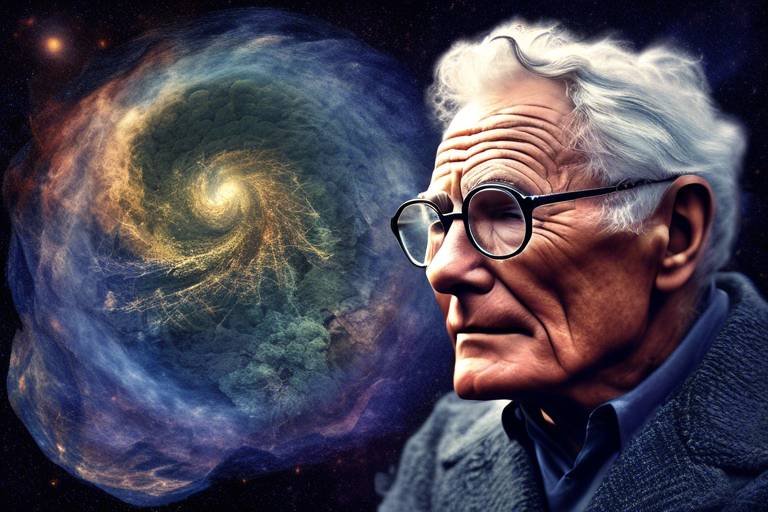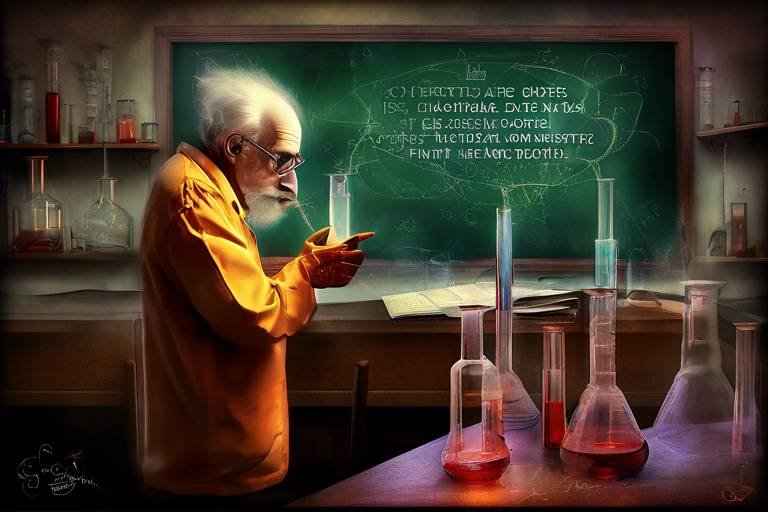Rosalind Franklin - The Woman Behind DNA Discovery
When we think about the discovery of DNA, names like Watson and Crick often come to mind, but there’s a remarkable woman whose contributions were crucial yet largely overlooked: Rosalind Franklin. Born on July 25, 1920, in London, Franklin's journey was anything but ordinary. She was a trailblazer in a male-dominated field, and her work not only advanced our understanding of genetics but also paved the way for future generations of female scientists. Imagine standing at the precipice of one of the most significant scientific breakthroughs of the 20th century, only to find that your name is often left out of the narrative. That was the reality for Franklin, whose meticulous research and innovative techniques in X-ray crystallography unlocked the secrets of DNA's structure. In this article, we delve into her life, her groundbreaking work, and the legacy she left behind that continues to inspire.
Rosalind Franklin's formative years in London were marked by a strong educational foundation and a deep curiosity about the world around her. Raised in a Jewish family that valued education, she attended St. Paul's Girls' School, where her interest in science began to flourish. Franklin's academic journey led her to the prestigious University of Cambridge, where she earned a degree in Natural Sciences. It was here that she honed her skills in physics and chemistry, setting the stage for her future contributions to molecular biology. After completing her degree, Franklin continued her studies at the University of Paris, where she was introduced to the world of X-ray crystallography—a technique that would become her hallmark.
Upon returning to England, Franklin took a position at King's College London, where her research on DNA began to take shape. Her work on X-ray crystallography was groundbreaking; she developed techniques that allowed her to capture detailed images of DNA fibers. These images revealed critical insights into the molecular structure of DNA, which were pivotal for understanding how genetic information is stored and transmitted. Franklin's meticulous methods and attention to detail set her apart from her peers, and her findings laid the groundwork for future breakthroughs in molecular biology. The elegance of her X-ray diffraction images showcased the helical structure of DNA, a finding that would later be instrumental for Watson and Crick.
Franklin's innovative approach to X-ray crystallography was nothing short of revolutionary. She employed a technique that involved precisely aligning DNA fibers and then directing X-rays at them, capturing the resulting diffraction patterns. These patterns provided invaluable data, revealing the dimensions and shape of the DNA molecule. Her famous Photograph 51, an X-ray diffraction image of DNA, was a key piece of evidence that led to the eventual discovery of the double helix structure. It’s fascinating to think about how a single photograph could change the course of science forever!
Despite her groundbreaking contributions, Franklin faced numerous challenges throughout her career. The scientific community of her time was rife with gender bias, and her work often went unrecognized. She struggled to gain the respect of her male colleagues, who frequently overshadowed her contributions. This lack of recognition was not just a personal setback; it reflected the broader societal barriers that women faced in science during the mid-20th century. Imagine working tirelessly on a project, only to see others reaping the accolades for your hard work. Franklin's story is a poignant reminder of the importance of acknowledging all contributors in scientific discovery.
Franklin's relationships with her colleagues were complex and often strained. While she collaborated with prominent scientists, including Maurice Wilkins, the dynamics were fraught with competition and differing scientific perspectives. This tension sometimes hindered the sharing of crucial information. Despite these challenges, Franklin's ability to produce high-quality data was undeniable, and her contributions were essential to the DNA research that unfolded during her time at King's College.
Franklin's work had a profound impact on the discovery of DNA's double helix structure. Her X-ray diffraction data provided the crucial evidence that Watson and Crick needed to formulate their famous model. It’s incredible to think that while they were celebrated for their discovery, Franklin's pivotal role was largely ignored for decades. Her findings not only advanced our understanding of genetics but also opened up new avenues for research in molecular biology.
Although often overlooked during her lifetime, Rosalind Franklin's legacy has gained significant recognition in recent years. Her story has become an inspiration for many, particularly women pursuing careers in STEM fields. The scientific community has begun to acknowledge her contributions, and her name is increasingly celebrated alongside those of her male counterparts. Franklin's resilience in the face of adversity serves as a powerful reminder of the importance of diversity and inclusion in science.
Since her passing in 1958, Franklin has received numerous posthumous awards and honors, acknowledging her contributions to science. These accolades serve as a reminder of her vital role in the history of molecular biology and the importance of recognizing the contributions of all scientists, regardless of gender. Some notable honors include:
- The Rosalind Franklin Award, which celebrates women in science.
- The naming of the Rosalind Franklin Institute in the UK, dedicated to advancing life sciences.
- Induction into the National Women's Hall of Fame.
Franklin's work continues to influence modern scientific research, particularly in genetics and biochemistry. Her methodologies and discoveries remain foundational in understanding the complexities of DNA and heredity. Today, her legacy serves as a beacon for aspiring scientists, reminding them that perseverance and dedication can lead to groundbreaking discoveries, regardless of the obstacles they may face.
- What was Rosalind Franklin's major contribution to science?
Franklin's major contribution was her groundbreaking work in X-ray crystallography, which provided crucial evidence for the double helix structure of DNA. - Why is Rosalind Franklin often overlooked in the history of DNA discovery?
Franklin's contributions were overshadowed by her male colleagues, and societal gender biases at the time led to her work being under-recognized. - What honors has Rosalind Franklin received posthumously?
She has received numerous awards, including the Rosalind Franklin Award and recognition in the National Women's Hall of Fame.

Early Life and Education
Rosalind Franklin was born on July 25, 1920, in London, England, into a well-off Jewish family that valued education highly. From a young age, she exhibited an insatiable curiosity about the world around her, often asking questions that would stump even the adults in her life. Her parents, who were both supportive of her academic pursuits, encouraged her to explore her interests, particularly in science. This nurturing environment played a pivotal role in shaping her future as a groundbreaking scientist.
Franklin's educational journey began at St. Paul's Girls' School, where she excelled in her studies, particularly in the sciences. Her passion for chemistry was ignited during her time there, leading her to pursue higher education at the University of Cambridge. In 1938, she enrolled at Newnham College, where she studied Natural Sciences. Her time at Cambridge was marked by rigorous academic training and exposure to the latest scientific ideas, which laid a solid foundation for her future research endeavors.
During her time at Cambridge, Franklin faced several challenges, including the male-dominated environment of the scientific community. However, she persevered, earning her degree in 1941. Following her graduation, she took a position at the British Coal Utilisation Research Association, where she conducted research on the physical chemistry of coal. This experience not only honed her technical skills but also ignited her interest in X-ray crystallography, a technique that would later become central to her work on DNA.
In 1947, Franklin moved to Paris to work at the Laboratoire Central des Services Chimiques de l'État. Here, she further developed her expertise in X-ray diffraction techniques, which would prove invaluable in her later studies. The time she spent in Paris was transformative, allowing her to collaborate with some of the leading scientists of the time and deepening her understanding of crystallography. This period marked the beginning of her journey toward uncovering the secrets of DNA, setting the stage for her remarkable contributions to molecular biology.
In summary, Rosalind Franklin's early life and education were characterized by a strong support system, academic excellence, and a relentless pursuit of knowledge. Her formative experiences not only shaped her scientific acumen but also instilled in her a passion for discovery that would drive her groundbreaking work in the years to come.

Career at King's College
Rosalind Franklin's career at King's College London marked a pivotal chapter in her life, where her scientific prowess began to shine like a beacon in the murky waters of molecular biology. Her appointment in 1951 as a research associate in the biophysics department opened doors to groundbreaking research that would ultimately change our understanding of DNA. At King's College, Franklin was immersed in the study of X-ray crystallography, a technique that would become her signature tool. This method allowed her to create detailed images of molecular structures, and she quickly became known for her meticulous attention to detail and her ability to produce high-quality data.
During her time there, Franklin worked alongside some of the brightest minds in science, yet she often found herself at odds with the prevailing attitudes of the time. The academic environment was competitive, and she faced significant challenges, including gender bias and a lack of recognition for her contributions. Despite these obstacles, she remained focused on her research, driven by an insatiable curiosity and a passion for discovery. Her work on the structure of DNA was not just a job; it was a calling that fueled her every day.
One of her most notable achievements at King's College was the development of innovative X-ray diffraction techniques. Franklin's approach was revolutionary, as she meticulously refined the process to extract the most accurate structural information possible. Her famous Photograph 51, an X-ray diffraction image of DNA, was a game-changer. This image revealed the helical structure of DNA, providing a visual representation that was crucial for understanding how genetic information is stored and transmitted.
To illustrate her contributions, consider the following table, which highlights key aspects of her work at King's College:
| Aspect | Details |
|---|---|
| Position | Research Associate in Biophysics |
| Key Technique | X-ray Crystallography |
| Notable Achievement | Photograph 51 |
| Challenges | Gender Bias, Lack of Recognition |
Franklin's work laid the groundwork for future breakthroughs in molecular biology. Her rigorous scientific methods and innovative techniques not only advanced the field but also established a standard for future researchers. She was not just a participant in the scientific community; she was a trailblazer, paving the way for others to follow. Despite the challenges she faced, Franklin's career at King's College was marked by a relentless pursuit of knowledge and an unwavering commitment to her research.
In summary, Rosalind Franklin's time at King's College was characterized by significant scientific contributions that would eventually lead to the discovery of the DNA double helix. Her legacy is a testament to the power of perseverance and passion in the face of adversity, and her story continues to inspire countless scientists today.
- What was Rosalind Franklin's major contribution to the discovery of DNA?
Franklin's major contribution was her work on X-ray crystallography, particularly her famous Photograph 51, which provided critical evidence for the helical structure of DNA. - Why was Rosalind Franklin's work not recognized during her lifetime?
Franklin faced significant gender bias and was often overshadowed by her male colleagues, which contributed to her lack of recognition during her lifetime. - What challenges did Rosalind Franklin face in her career?
She encountered gender bias, lack of recognition, and strained relationships with colleagues, which made her scientific journey particularly challenging.

X-ray Crystallography Techniques
Rosalind Franklin's groundbreaking work in X-ray crystallography was nothing short of revolutionary. Her innovative techniques not only advanced the field of molecular biology but also provided critical insights into the structure of DNA. Imagine trying to piece together a puzzle without knowing what the final picture looks like; that's essentially what Franklin was doing with DNA. She meticulously developed methods to capture the intricate details of the DNA molecule, using X-ray diffraction to reveal its hidden secrets.
One of her most notable techniques involved the creation of high-quality DNA crystals. This was no easy feat, as DNA is a delicate molecule that requires precise conditions to crystallize effectively. Franklin's persistence and attention to detail paid off, leading to the production of sharp diffraction patterns that would become the cornerstone of her research. The resulting images were so clear that they allowed her to deduce the helical structure of DNA, a breakthrough that would change the course of biology forever.
To understand the significance of her work, it’s essential to delve into the fundamentals of X-ray crystallography. The process can be summarized in a few key steps:
- Preparation of Crystals: Franklin developed techniques to grow high-quality crystals of DNA, which was crucial for obtaining clear diffraction patterns.
- X-ray Diffraction: By directing X-rays at the crystallized DNA, she captured the resulting diffraction patterns, which provided information about the arrangement of atoms within the molecule.
- Data Analysis: Analyzing the diffraction patterns, Franklin was able to infer the dimensions and shape of the DNA helix, leading to her famous Photo 51, which visually represented the helical structure.
This meticulous process not only showcased Franklin's technical expertise but also her ability to interpret complex data. Her findings were pivotal in confirming that DNA existed in a double helical form, a concept that would later be popularized by James Watson and Francis Crick. However, it’s important to recognize that Franklin's contributions were often overshadowed by her male counterparts, highlighting the gender biases prevalent in the scientific community of her time.
In summary, Rosalind Franklin's X-ray crystallography techniques were instrumental in unlocking the mysteries of DNA. Her innovative approach and unwavering dedication to her research not only advanced our understanding of genetics but also paved the way for future discoveries in molecular biology. The legacy of her work continues to resonate, reminding us of the importance of recognizing the contributions of women in science and the need for a more inclusive scientific community.
- What is X-ray crystallography? X-ray crystallography is a technique used to determine the atomic and molecular structure of a crystal by scattering X-ray beams off the crystal lattice.
- How did Rosalind Franklin contribute to the discovery of DNA? Franklin's X-ray crystallography work provided critical data that led to the understanding of DNA's double helix structure, particularly through her famous Photo 51.
- Why was Franklin's work overlooked during her lifetime? Gender bias and the competitive nature of scientific research at the time contributed to the lack of recognition for Franklin's contributions.

Challenges Faced
Throughout her career, Rosalind Franklin faced a myriad of challenges that would have discouraged many. Despite her exceptional talent and groundbreaking contributions to science, she encountered significant obstacles, particularly stemming from the gender bias prevalent in the mid-20th century. In an era when the scientific community was largely dominated by men, Franklin often found herself fighting against a tide of skepticism and discrimination.
One of the most notable challenges was the lack of recognition for her work. While she was conducting pivotal research at King's College London, her contributions were frequently overshadowed by her male colleagues. For instance, the famous Watson and Crick model of DNA was built upon her X-ray diffraction images, yet she was not credited in the initial publications that celebrated their discovery. This situation exemplifies the broader issue of gender inequality in science, where women's contributions were often minimized or overlooked entirely.
Moreover, Franklin's meticulous nature and strong personality sometimes led to friction with her colleagues. Her insistence on accuracy and precision clashed with the more speculative approaches favored by some of her contemporaries. This tension was particularly evident in her interactions with James Watson and Francis Crick, who, despite ultimately benefiting from her findings, did not always appreciate her rigorous methods. Such dynamics illustrate the complexity of collaboration in scientific research, where egos and ambitions can sometimes complicate the pursuit of knowledge.
In addition to these interpersonal challenges, Franklin also faced institutional barriers. The scientific community at the time was not fully equipped to support women in research roles. She often had to navigate a landscape where opportunities for advancement were limited, and recognition was hard-earned. The struggle for acceptance and respect in a male-dominated field was a constant battle for Franklin, yet she persevered, driven by her passion for science and discovery.
In summary, the challenges faced by Rosalind Franklin were not merely personal hurdles; they reflected a broader societal issue of gender bias in science. Her story serves as a reminder of the resilience required to overcome such obstacles and the importance of recognizing the contributions of women in the scientific community. It is essential to acknowledge these struggles to understand the full impact of her legacy on modern science.
- What was Rosalind Franklin's major contribution to science?
Franklin's major contribution was her work on X-ray crystallography, which provided critical evidence for the double helix structure of DNA.
- Why was Rosalind Franklin's work overlooked during her lifetime?
Her work was often overshadowed by her male colleagues due to gender bias and the competitive nature of scientific research at the time.
- What challenges did Franklin face as a woman in science?
Franklin faced gender discrimination, lack of recognition for her contributions, and difficulties in collaboration with male scientists.
- How has Rosalind Franklin's legacy been recognized posthumously?
Franklin has received numerous awards and honors, and her story has inspired a new generation of scientists, particularly women in STEM.

Collaboration with Colleagues
Rosalind Franklin's journey in the scientific community was marked by both collaboration and competition. At King's College London, she worked alongside prominent scientists, yet her interactions were often complicated by the prevailing attitudes of the time. While she shared a laboratory with colleagues like Maurice Wilkins, the dynamics were not always harmonious. Franklin's meticulous approach to research sometimes clashed with the more casual attitudes of her peers. This tension was further exacerbated by the fact that her groundbreaking work on DNA's structure was not fully appreciated by everyone in her circle.
Despite these challenges, Franklin's collaborations did yield remarkable insights. For instance, her expertise in X-ray crystallography allowed her to produce some of the most detailed images of DNA, which were crucial for understanding its structure. However, it was a double-edged sword; while her data was essential, it often led to feelings of rivalry, particularly with Watson and Crick, who were also pursuing the DNA puzzle. The competitive nature of scientific discovery can sometimes overshadow the collaborative spirit that is essential for innovation.
To illustrate the complexity of her collaborations, consider the following points:
- Shared Goals: All researchers were driven by a common desire to unlock the secrets of DNA, which sometimes fostered a sense of camaraderie.
- Intellectual Rivalry: The race to be the first to discover the double helix structure created a competitive atmosphere that strained relationships.
- Recognition Issues: Franklin's contributions were often overshadowed by her male counterparts, leading to feelings of frustration and isolation.
Ultimately, while Franklin's collaborations were fraught with challenges, they were also pivotal in advancing our understanding of molecular biology. Her ability to navigate these relationships, despite the obstacles, speaks volumes about her character and dedication to science. Today, her legacy serves as a powerful reminder of the importance of recognizing and valuing contributions from all members of the scientific community, regardless of gender.
- What was Rosalind Franklin's main contribution to science?
Rosalind Franklin's main contribution was her work on X-ray crystallography, which provided crucial insights into the structure of DNA, leading to the discovery of its double helix form. - Why was Rosalind Franklin's work not recognized during her lifetime?
Franklin faced significant gender bias and her contributions were often overshadowed by her male colleagues, particularly Watson and Crick, who received the Nobel Prize for their work on DNA. - What legacy did Rosalind Franklin leave behind?
Franklin's legacy is one of resilience and pioneering spirit, inspiring future generations of scientists, especially women in STEM fields, to pursue their passions in science.

Impact on DNA Discovery
Rosalind Franklin's contributions to the discovery of DNA's structure were not just significant; they were transformative. Her meticulous research and innovative techniques provided the essential clues that led to one of the most important scientific breakthroughs of the 20th century. Imagine being a detective piecing together a complex puzzle; that was Franklin's role in the world of molecular biology. Her X-ray diffraction images of DNA were the key pieces that unlocked the mystery of its helical structure.
While James Watson and Francis Crick are often credited with the discovery of the double helix, it is crucial to recognize that their model was built on the foundation laid by Franklin's work. Her famous Photograph 51, an X-ray diffraction image, captured the essence of DNA's structure with unparalleled clarity. This image not only revealed the helical nature of DNA but also hinted at the spacing of the bases within the structure. Without her precise and detailed imaging techniques, Watson and Crick may not have achieved their groundbreaking model as swiftly or accurately.
Moreover, Franklin's research was characterized by her use of X-ray crystallography, a technique that allowed her to visualize the atomic structure of complex molecules. Her ability to produce high-quality images of DNA was a result of her rigorous attention to detail and her understanding of the physical properties of the materials she was studying. This technical expertise was essential in providing the data needed to confirm the double helical structure, which has since become a cornerstone of modern genetics.
To illustrate the direct impact of Franklin's work on the DNA discovery, consider the following table:
| Key Contribution | Description | Impact on DNA Discovery |
|---|---|---|
| Photograph 51 | X-ray diffraction image of DNA | Provided evidence for helical structure |
| X-ray Crystallography | Technique for visualizing molecular structures | Enabled detailed analysis of DNA structure |
| Base Pairing Insights | Understanding the arrangement of bases | Critical for Watson and Crick's model formulation |
It’s also worth noting that Franklin's work extended beyond DNA; her research on viruses and coal provided insights that would influence various fields within biology and chemistry. However, the legacy of her contributions to DNA research remains particularly profound. Today, as we delve into the realms of genetics and biotechnology, we often reflect on the pivotal role that Franklin played. Her findings have paved the way for advances in genetic engineering, forensic science, and even personalized medicine.
In essence, Rosalind Franklin's impact on DNA discovery is a testament to the power of dedication and innovation. Her story serves as a reminder that behind every great scientific achievement lies the often-unrecognized work of individuals who dared to ask questions, challenge norms, and pursue their passion for discovery. As we continue to explore the genetic code that defines life, we must acknowledge and celebrate the contributions of Rosalind Franklin, a true pioneer in the field of molecular biology.
- What was Rosalind Franklin's main contribution to the discovery of DNA?
Franklin's main contribution was her X-ray diffraction image of DNA, known as Photograph 51, which provided critical evidence for the helical structure of DNA.
- Why was Rosalind Franklin's work overlooked during her lifetime?
Franklin faced gender bias and was often overshadowed by her male colleagues, which contributed to her lack of recognition during her career.
- How did Franklin's work influence modern science?
Her research laid the foundation for advancements in genetics, biochemistry, and molecular biology, influencing various fields including medicine and biotechnology.

Legacy and Recognition
Rosalind Franklin's legacy is nothing short of remarkable. Although she faced significant challenges during her lifetime, including gender bias and a lack of recognition, her contributions to science have gained considerable acknowledgment in recent years. It’s fascinating to think that a woman whose work was so pivotal to one of the greatest scientific discoveries of the 20th century was often overshadowed by her male counterparts. Yet, her story is a testament to perseverance and brilliance, inspiring countless individuals, especially women, to pursue careers in STEM fields.
In the years following her death, the scientific community began to recognize the depth of her contributions to molecular biology. Today, Franklin is celebrated not only for her role in elucidating the structure of DNA but also for her pioneering work in virology and coal research. Her meticulous techniques and innovative approaches have become foundational in various scientific disciplines. This recognition is vital, as it encourages a new generation of scientists to challenge the status quo and strive for excellence regardless of societal barriers.
To illustrate the impact of her legacy, let’s take a look at some of the posthumous honors and awards that have been bestowed upon her:
| Award | Year | Description |
|---|---|---|
| Rosalind Franklin Award | 2003 | Awarded by the National Academy of Sciences to honor women scientists. |
| Franklin Medal | 2017 | Presented by the Franklin Institute for outstanding contributions to science. |
| Induction into the National Women's Hall of Fame | 2019 | Recognized for her contributions to science and society. |
These honors serve as a reminder of her vital role in the history of molecular biology and the ongoing need to recognize the contributions of women in science. Furthermore, her legacy extends beyond awards and accolades; it lies in the inspiration she provides to aspiring scientists. Today, many educational institutions and organizations celebrate her achievements, ensuring that her story is told and retold, creating a ripple effect that empowers future generations.
Moreover, the impact of Franklin's work continues to resonate in modern science. Her methodologies are still taught in laboratories around the world, and her findings are foundational in the fields of genetics and biochemistry. The double helix model of DNA, which was heavily influenced by her research, remains a cornerstone of biological science, illustrating how her legacy is woven into the very fabric of modern scientific inquiry.
In conclusion, Rosalind Franklin's legacy is not merely a footnote in the annals of science; it is a powerful narrative of resilience, intellect, and groundbreaking discovery. As we continue to celebrate her contributions, we must also reflect on the importance of recognizing the achievements of all scientists, regardless of gender, and strive to create an inclusive environment where everyone has the opportunity to shine.
- What was Rosalind Franklin's main contribution to the discovery of DNA?
Franklin's main contribution was her pioneering work in X-ray crystallography, which produced critical images and data that revealed the helical structure of DNA.
- Why was Rosalind Franklin's work not recognized during her lifetime?
During her lifetime, Franklin faced significant gender bias and was often overshadowed by her male colleagues, leading to a lack of recognition for her contributions.
- What honors has Rosalind Franklin received posthumously?
Franklin has received numerous posthumous awards, including the Rosalind Franklin Award and induction into the National Women's Hall of Fame, acknowledging her significant contributions to science.

Posthumous Honors
Rosalind Franklin's contributions to science, particularly in the field of molecular biology, were not fully recognized during her lifetime. However, following her untimely death in 1958, the scientific community began to appreciate the magnitude of her work. Today, her legacy is celebrated through numerous posthumous honors that reflect her vital role in the discovery of DNA's structure.
One of the most significant recognitions came in 1962 when the Nobel Prize in Physiology or Medicine was awarded to James Watson, Francis Crick, and Maurice Wilkins for their work on the structure of DNA. Although Franklin was not included in this prestigious award, many believe that her research was instrumental in their findings. In recent years, there has been a growing acknowledgment of her contributions, leading to various awards and honors that celebrate her legacy.
Some notable posthumous honors awarded to Rosalind Franklin include:
- The Rosalind Franklin Society, established in 2016, aims to promote the advancement of women in science, technology, engineering, and mathematics (STEM) fields.
- In 2019, she was posthumously inducted into the National Women's Hall of Fame, recognizing her as a pioneer for women in science.
- Numerous scholarships and fellowships have been named in her honor, aimed at supporting young women pursuing careers in STEM.
Moreover, Franklin's legacy has been cemented in popular culture and academia. Books, documentaries, and films have been produced to tell her story, shedding light on her contributions and the challenges she faced as a woman in a male-dominated field. These narratives not only honor her memory but also inspire future generations of scientists to persevere against the odds.
As we reflect on the impact of Rosalind Franklin's work, it becomes clear that her story is not just about scientific discovery but also about resilience and the fight for recognition in a world that often overlooks the contributions of women. Her posthumous honors serve as a powerful reminder of the importance of diversity in science and the need to celebrate all contributors to our understanding of the natural world.
1. What was Rosalind Franklin's main contribution to science?
Franklin's main contribution was her pioneering work in X-ray crystallography, which provided crucial data for understanding the double helix structure of DNA.
2. Why wasn't Rosalind Franklin awarded the Nobel Prize?
Franklin passed away before the Nobel Prize was awarded to Watson, Crick, and Wilkins in 1962. The prize is not awarded posthumously, and her contributions were not fully acknowledged during her lifetime.
3. How has Rosalind Franklin's legacy influenced modern science?
Franklin's methodologies and discoveries continue to influence fields such as genetics and biochemistry, highlighting the importance of her work in understanding DNA and heredity.
4. What honors have been established in Rosalind Franklin's name?
Honors include the Rosalind Franklin Society, various scholarships and fellowships, and her induction into the National Women's Hall of Fame.

Influence on Modern Science
Rosalind Franklin's impact on modern science is nothing short of revolutionary. Her pioneering work in X-ray crystallography not only illuminated the structure of DNA but also laid the groundwork for numerous advancements in genetics and molecular biology. Imagine a world where the secrets of heredity and genetic disorders remain locked away, shrouded in mystery. Thanks to Franklin's meticulous research, we can now delve into the very essence of life itself.
One of the most significant ways her work influences modern science is through the techniques she developed. Franklin's innovative X-ray diffraction methods were groundbreaking and have since been adapted and refined for various applications in scientific research. Today, these techniques are essential in fields such as:
- Structural Biology: Understanding the 3D structures of proteins and nucleic acids.
- Genetics: Analyzing genetic material to discern mutations and hereditary diseases.
- Biochemistry: Investigating the molecular mechanisms of biological processes.
Moreover, Franklin's legacy extends beyond her technical contributions. She serves as a beacon of inspiration for countless scientists, particularly women in STEM. Her story is a powerful reminder that perseverance in the face of adversity can lead to groundbreaking discoveries. As more women enter the scientific field, they often cite Franklin as a role model, encouraging a more inclusive and diverse scientific community.
Furthermore, the ethical implications of her work resonate in contemporary discussions about scientific integrity and collaboration. The dynamics of her relationship with Watson and Crick serve as a case study in the importance of recognition and credit in scientific endeavors. As we navigate the complexities of modern research, Franklin's experiences underscore the necessity for transparency and equity in scientific collaboration.
In summary, Rosalind Franklin's influence on modern science is profound and multifaceted. From the techniques she pioneered to the inspiration she provides, her contributions continue to shape our understanding of biology and genetics. As we explore the intricacies of life at the molecular level, we must remember the woman whose dedication and brilliance unlocked the door to these mysteries.
- What was Rosalind Franklin's main contribution to DNA research?
Franklin's primary contribution was her work with X-ray crystallography, which provided critical images and data that led to the discovery of the DNA double helix structure. - Why was Rosalind Franklin's work initially overlooked?
Franklin faced significant gender bias and was often overshadowed by her male colleagues, which contributed to her lack of recognition during her lifetime. - How does Rosalind Franklin inspire modern scientists?
Her story encourages perseverance, resilience, and the importance of equitable recognition in scientific research, particularly for women in STEM fields.
Frequently Asked Questions
- Who was Rosalind Franklin?
Rosalind Franklin was a pioneering scientist whose work in X-ray crystallography was crucial for understanding the structure of DNA. Despite facing significant challenges, including gender bias, her meticulous research laid the groundwork for major breakthroughs in molecular biology.
- What was Franklin's contribution to the discovery of DNA?
Franklin's most notable contribution was her production of high-quality X-ray diffraction images of DNA, particularly Photo 51, which provided vital evidence for the double helix structure. Her data was instrumental for Watson and Crick in formulating their famous DNA model.
- What challenges did Rosalind Franklin face during her career?
Throughout her career, Franklin encountered numerous obstacles, including gender discrimination and a lack of recognition for her contributions. These challenges were reflective of the broader societal barriers women faced in science during the mid-20th century.
- How did Franklin's work influence modern science?
Franklin's research continues to impact various fields, particularly genetics and biochemistry. Her innovative methodologies and discoveries are foundational to our current understanding of DNA and heredity, influencing ongoing research in these areas.
- Has Rosalind Franklin received any posthumous recognition?
Yes, Franklin has been honored with numerous awards and recognitions after her death, acknowledging her significant contributions to science. These accolades serve as a reminder of her vital role in the history of molecular biology and inspire future generations of scientists.
- What techniques did Franklin develop for studying DNA?
Franklin developed advanced X-ray crystallography techniques that allowed her to capture detailed images of DNA. Her precise methods revealed critical structural information, which was essential for understanding the helical nature of the DNA molecule.
- What was the nature of Franklin's collaborations with other scientists?
Franklin's collaborations were often complex and sometimes strained due to competition and differing scientific perspectives. While she worked alongside notable scientists, her contributions were not always fully recognized, leading to tension in some professional relationships.



















